How old is the Earth?

Introduction
We have been conditioned by the media to accept without questioning that the earth is billions of years old. An old earth is the “sacred cow” of evolutionists, because billions of years are needed for life to evolve. But is this unquestioned faith in an old earth justified? Is there really solid scientific evidence to support it? More importantly, what does the Bible have to say on the matter?
We will first look and what the Bible says and then briefly look at the scientific evidence.
The Old Testament and the Age of the Earth
Genesis 1 gives an account of creation. The first verse states that God created the heavens and the earth.
Genesis 1:1 In the beginning God created [bara] the heavens [shamayim] and the earth [erets].
The subsequent verses in Genesis show that the creation took six days and that God rested on the seventh day. This is confirmed by two other Scriptures.
Exodus 20:11 For in six days the LORD made [asah] the heavens [shamayim] and the earth [erets], the sea, and all that is in them, and rested the seventh day. Therefore the LORD blessed the Sabbath day and hallowed it.
Exo 31:16 Therefore the children of Israel shall keep the Sabbath, to observe the Sabbath throughout their generations as a perpetual covenant.
Exo 31:17 It is a sign between Me and the children of Israel forever; for in six days the LORD made [asah] the heavens [shamayim] and the earth [erets], and on the seventh day He rested and was refreshed.’ “
The same Hebrew words for heavens [shamayim] and earth [erets] are used in the above verses, so all three verses are referring to the same thing. (The Hebrew word translated heavens, shamayim, means the sky as well as the space where the celestial bodies revolve.) The plain reading of these verses is that God created the whole universe in six days. And when you read the genealogies going from Adam to Noah to Abraham to Jesus Christ, it is clear that creation is relatively recent–about six thousand years ago.
For hundreds of years, that is how most Christians have understood the Biblical account of creation. There is no reason to understand otherwise unless there is some driving force external to the Bible. That force is the philosophy behind modern day science, which is the rejection of God and the acceptance of evolution with its required billions of years. I use the word philosophy because there is plenty of scientific evidence for a young earth, but in general it is rejected by scientists on philosophical grounds. This philosophy of modern-day science saturates the media and seeps into unsuspecting minds. Unfortunately, the thinking of many Christians is influenced without them knowing. They reject the plain reading of Scripture which shows God created the whole universe in six days recently and look for ways to shoehorn an old universe and earth (aged billions of years) into Scripture. We will now take a look at how they do this and the problems with it.
The New Testament and the Age of the Earth
Does the New Testament shed any light on the age of the earth? Let’s take a look at how Jesus Christ viewed the age of the world.
Mark 10:6 “But from the beginning of the creation, God ‘made them male and female.’
Jesus viewed the “beginning of creation” as the time when God made Adam and Eve, not billions of years ago.
Luke 11:50 “that the blood of all the prophets which was shed from the foundation of the world may be required of this generation,
Jesus assured us that prophets had been around since the foundation of the world. The Greek for foundation is katabole, which means founding or conception, and the Greek for world is kosmos, from which we get the English word cosmos. So prophets have been around since the founding or conception of the world or universe. It leaves no room for billions of years for the age of the world.
Paul also made it clear that people can clearly see God’s power by looking at the “things that are made”, and that people have been able to see this ‘since the creation of the world’, not billions of years after creation.
Romans 1:20 For since the creation of the world His invisible attributes are clearly seen, being understood by the things that are made, even His eternal power and Godhead, so that they are without excuse,
The New Testament affirms the Old Testament account of the creation of the whole universe occurring in the creation week.
Examining the Theological Argument for an Old Earth
Those who believe in an old earth argue that Genesis 1:1 describes the creation of the heavens (outer space, sun, moon, and stars) and the earth. Then they insert a gap of billions of years, between verse 1 and 2, when the earth supposedly became without form and void by the angelic rebellion. They argue that verse 2 onwards is a remaking of the earth. As you can see, a fair amount of additional material is added, which is not found in Scripture.
A supposed gap
The theological argument for a gap focuses on the first phrase of Genesis 1:2.
Gen 1:2 The earth was without form [tohu], and void [bohu]; …
The words “without form” and “void” are translated from the Hebrew tohu and bohu. Tohu also appears in Isaiah 45:18, the Scripture cited to support a gap, which states that God did not create the heavens and earth in vain (tohu)..
Isaiah 45:18 For thus says the LORD, Who created [bara] the heavens [shamayim], Who is God, Who formed the earth [erets] and made it, Who has established it, Who did not create it in vain [tohu], Who formed it to be inhabited: “I am the LORD, and there is no other.
They reason that there is a gap between verses 1 and 2 of Genesis 1 during which the creation became “without form” or “void”. Note that there is no theological argument for the length of the gap. The supposed length of billions of years is not driven by theology but by faith in astronomers! Sadly, Christians who believe in a gap of billions of years are using their faith in astronomers to guide their theology.
What does Genesis 1:2 mean by stating “the earth was without form, and void”? It is a description of the earth at the start of the first day shortly after its creation. The first act of creation on the first day was the creation of the heavens and the earth. The earth was not initially created with geological formations (mountains and rivers); it was without form. Nor was the earth initially created full of life (plants and animals); it was void or empty. The earth was covered with water; there was no dry land at this point, as dry land appeared on the third day.
What does Isaiah 45:18 means by stating God did not create the heavens and earth in vain? The very next phrase, “Who formed it to be inhabited”, answers the question. God did not create the heavens and earth for no purpose, but to be inhabited.
Was or Became?
Another element in the theological argument for an old earth is their belief that the “was” in Genesis 1:2 (the earth was) should be translated “became” (the earth became). I say belief because there is very little to support it. Appendix A at the end lists 83 different older translations. (Modern translations have not been examined because most are not very reliable.) 75 have “the earth was”, 3 have “the earth being”, 1 has “the earth hath existed”, and 4 “the earth had become” as their translation. Only 4 out of 83 (just under 5%) of the translations have anything like “the earth became”. The weight of scholarship favours by far the translation: “the earth was”.
Angelic Rebellion
Scripture is clear that Satan and his demons rebelled against God. Isaiah 14 and Ezekiel 28 show that Satan was initially created perfect, but that he sinned and rebelled against God. Those who believe in an old earth argue that Satan rebelled billions of years ago and that His rebellion (as a spirit being) caused physical devastation on the earth (and planets). However, there is nothing in Scripture to support this notion.
A Re-creation?
Those who believe in an old earth argue that the earth was devasted between verses 1 and 2 of Genesis 1. This means that the creation described from Genesis 1:2 onwards is a re-creation.
Sometimes they use Genesis 1:28 to support this, where God instructs Adam and Eve, “Be fruitful, and multiply, and replenish the earth” (King James Version). However, the Hebrew word translated replenish does not mean to re-fill but simply to fill. Many translations, such as The New King James version, render it correctly as “fill the earth”.
Another verse sometimes used is Psalm 104:30.
Psa 104:30 You send forth Your Spirit, they are created; And You renew the face of the earth.
However, the context is not creation or re- creation, but animals’ reliance on God for their survival.
Psa 104:27 These all wait for You, That You may give them their food in due season.
Psa 104:28 What You give them they gather in; You open Your hand, they are filled with good.
Psa 104:29 You hide Your face, they are troubled; You take away their breath, they die and return to their dust.
Made or Appointed?
Those who believe in an old earth also point out the two different Hebrew words used for describing the creation: bara and asah. The Hebrew word translated created in Genesis 1:1 is bara, which means to create or make, and the Hebrew word translated made in Exodus 20:11 and Exodus 31:17 is asah, which means to make, do, appoint, bring forth, dress.
They argue that God created the heavens and the earth billions of years ago; but appointed the already existing heavens and the earth and all that is in them in six days at the “re-creation”. But they are forced to admit that the rest of the chapter makes no such distinction. For example, God created sea creatures but made the beasts of the earth.
Genesis 1:21 So God created [bara] great sea creatures and every living thing that moves, with which the waters abounded, according to their kind, and every winged bird according to its kind. And God saw that it was good.
Genesis 1:25 And God made [asah] the beast of the earth according to its kind, cattle according to its kind, and everything that creeps on the earth according to its kind. And God saw that it was good.
No one argues that God created the sea creatures but appointed already existing land animals. Another example is God both making and creating man.
Genesis 1:26 Then God said, “Let Us make [asah] man in Our image, according to Our likeness; let them have dominion over the fish of the sea, over the birds of the air, and over the cattle, over all the earth and over every creeping thing that creeps on the earth.”
Genesis 1:27 So God created [bara] man in His own image; in the image of God He created [bara] him; male and female He created [bara] them.
There is no indication from Genesis 1 that “asah” should be understood to mean “appointed” rather than “made” in Exodus 20:11 and Exodus 31:17. There is simply no good theological reason for this view.
It is clear that the theological argument for an old earth is based on ideas not found in Scripture. And where Scriptures are invoked, they are interpreted in an unnatural way which assumes what is trying to be proved.
Satan’s Rebellion in the Context of a Young Earth
The theological argument for an old earth includes the idea that Satan’s rebellion took place millions of years ago and coincided with the extinction of the dinosaurs (who supposedly lived millions of years ago). There is no theological substance to the figure of millions of years. It is derived by faith in palaeontologists and then shoehorned into the Bible. One of the questions asked by Christians who hold to an old earth and a Satanic rebellion millions of years ago is, “When did Satan rebel?” They seem to think that the Bible teaches an ancient Satanic rebellion, and that this somehow proves the earth is old. Neither statement is correct. The Bible does not tell us how long-ago Satan rebelled, and a recent or ancient Satanic rebellion both agree with a young earth. We discuss this further below.
We should set the background first by understanding that the angelic realm was created before the physical creation. We know this because God tells us that the “sons of God”, the angels, shouted for joy at the physical creation.
Job 38:4 “Where were you when I laid the foundations of the earth? Tell Me, if you have understanding.
…
Job 38:7 When the morning stars sang together, And all the sons of God shouted for joy?
Their argument is basically as follows. Satan rebelled millions of years ago. Having rebelled, Satan was thrown down to the earth. Therefore, the earth existed millions of years ago.
As mentioned before, the Bible does not tell us when Satan rebelled, so there is already an assumption built into their argument. What about the second part of the argument, that Satan was thrown down to the earth? Let’s consider the relevant Scriptures.
After the seventy, who Jesus sent out, returned, they reported that the demons were subject to them in Jesus’s name. Jesus responded, saying, “I saw Satan fall like lightning from heaven”.
Luke 10:18 And He said to them, “I saw Satan fall like lightning from heaven.
This almost certainly refers to Satan’s rebellion. Note that Jesus did not say where Satan fell to, only where he fell from. There is no mention of the earth.
The next relevant Scripture is in Isaiah 14, where God describes Satan’s rebellion.
Isa 14:12 “How you are fallen from heaven, O Lucifer, son of the morning! How you are cut down to the ground, You who weakened the nations!
Note that it says of Satan, “How you are cut down to the ground”. The Hebrew word translated ground is erets, which means: ground, land, earth, that which is firm. It doesn’t necessarily mean the planet earth. It could simply mean that Satan was cut down to size – to rock bottom. Or it could mean some kind of ground in the spirit realm. It could also be that the first part of the verse is history and the second part, “How you are cut down to the ground, You who weakened the nations”, is prophetic, a future event referring to Satan’s punishment. This seems quite a likely explanation, because when Satan rebelled there were no nations, so how can he have weakened them? With these considerations in mind, clearly Isa 14:12 is not in any way proof that Satan fell to earth after his rebellion.
The next relevant Scripture is Ezekiel 28, where God also describes Satan’s rebellion.
Eze 28:14 “You were the anointed cherub who covers; I established you; You were on the holy mountain of God; You walked back and forth in the midst of fiery stones.
…
Ezek 28:17 “Your heart was lifted up because of your beauty; You corrupted your wisdom for the sake of your splendor; I cast you to the ground [erets], I laid you before kings, That they might gaze at you.
Ezek 28:18 “You defiled your sanctuaries By the multitude of your iniquities, By the iniquity of your trading; Therefore I brought fire from your midst; It devoured you, And I turned you to ashes upon the earth [erets]In the sight of all who saw you.
Verse 14 is clearly talking about Satan, but verse 17 states, “I cast you to the ground, I laid you before kings”, and verse 18, “I turned you to ashes upon the earth”. If verses 17 and 18 refer to Satan (which they probably do) it’s a future event and has nothing to do with Satan’s initial rebellion.
With this in mind, Satan could have rebelled millions of years ago or relatively recently. The Scriptures which state Satan was cast to the ground, Isa 14:12 and Ezek 28:17-18, are almost certain prophetic, referring to his future punishment. And even if they refer to Satan’s initial rebellion, ground does not necessarily mean “the earth”. Therefore, there is nothing of substance to the supposed problem of Satan’s rebellion in the context of a young earth. To be clear, the Scriptural accounts of Satan’s rebellion do not in any way contradict a young earth.
The Bible and Dinosaurs
People always want to know about the dinosaurs. The burning question is: When did the dinosaurs live? According to the creation account in the Bible, dinosaurs were created on the sixth day since they were land animals.
The word dinosaur was invented in the 1800’s by Sir Richard Owen, a British anatomist, from two Greek words, deino and sauros, meaning “terrible lizard”. So the word dinosaur will not be found in any Bible translations prior to the 1800’s. Interestingly, the King James Version uses the word “dragon” or “dragons” in the Old Testament about 20 times where most other translations use “serpent” or “jackal”.
Does the Bible describe any creatures which could be dinosaurs? The answer is yes. The Bible describes two incredible creatures, that by any standards are like dinosaurs. The first is behemoth, Job 40:15-24 and the second leviathan, Job 41:1-34. Let’s consider the context before looking at the details. In Job 38 God asks Job a series of questions about His creation concerning how things were made and work. Initially the questions relate to the heavens and the earth and its weather, but later move on to various animals of which Job was clearly aware. The questioning follows the pattern of considering a particular part of creation and asking Job if he can explain how it works. The list of animals includes behemoth and leviathan. Clearly, for this questioning to be effective, Job must have seen or at least known of these creatures. Indeed, at no stage does Job indicate he is not aware of any of the things God refers to.
Let’s look at behemoth first.

Job 40:15 “Look now at the behemoth, which I made along with you; He eats grass like an ox.
God made behemoth along with Job, that is God made both man and behemoth at the same time (which was day six of creation). Behemoth is vegetarian, like sauropod dinosaurs.
Job 40:16 See now, his strength is in his hips, And his power is in his stomach muscles.
Job 40:17 He moves his tail like a cedar; The sinews of his thighs are tightly knit.
His tail is as big as cedar tree, like sauropod dinosaurs.
Job 40:18 His bones are like beams of bronze, His ribs like bars of iron.
His bones are a large as beams in a house, like sauropod dinosaurs. He is a big creature.
Job 40:19 He is the first of the ways of God; Only He who made him can bring near His sword.
Job 40:20 Surely the mountains yield food for him, And all the beasts of the field play there.
Job 40:21 He lies under the lotus trees, In a covert of reeds and marsh.
Job 40:22 The lotus trees cover him with their shade; The willows by the brook surround him.
Job 40:23 Indeed the river may rage, Yet he is not disturbed; He is confident, though the Jordan gushes into his mouth,
Job 40:24 Though he takes it in his eyes, Or one pierces his nose with a snare.
It looks very much like behemoth was a sauropod dinosaur.
Let’s look at leviathan next.
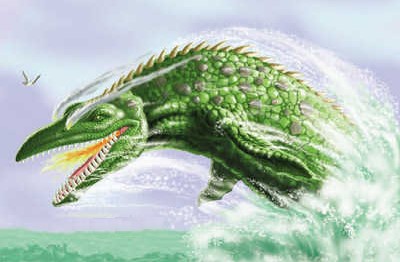
Job 41:1 “Can you draw out Leviathan with a hook, Or snare his tongue with a line which you lower?
Job 41:2 Can you put a reed through his nose, Or pierce his jaw with a hook?
Leviathan was a large sea creature; too large to catch with a hook.
Job 41:3 Will he make many supplications to you? Will he speak softly to you?
Job 41:4 Will he make a covenant with you? Will you take him as a servant forever?
Job 41:5 Will you play with him as with a bird, Or will you leash him for your maidens?
He cannot be tamed.
Job 41:6 Will your companions make a banquet of him? Will they apportion him among the merchants?
Job 41:7 Can you fill his skin with harpoons, Or his head with fishing spears?
Job 41:8 Lay your hand on him; Remember the battle— Never do it again!
Job 41:9 Indeed, any hope of overcoming him is false; Shall one not be overwhelmed at the sight of him?
He cannot be slaughtered.
Job 41:10 No one is so fierce that he would dare stir him up. Who then is able to stand against Me?
Job 41:11 Who has preceded Me, that I should pay him? Everything under heaven is Mine.
If no one can stand against Leviathan then no one can stand against His creator.
Job 41:12 “I will not conceal his limbs, His mighty power, or his graceful proportions.
Job 41:13 Who can remove his outer coat? Who can approach him with a double bridle?
Job 41:14 Who can open the doors of his face, With his terrible teeth all around?
He has rows of sharp teeth.
Job 41:15 His rows of scales are his pride, Shut up tightly as with a seal;
Job 41:16 One is so near another That no air can come between them;
Job 41:17 They are joined one to another, They stick together and cannot be parted.
He has scales tightly knitted together.
Job 41:18 His sneezings flash forth light, And his eyes are like the eyelids of the morning.
Job 41:19 Out of his mouth go burning lights; Sparks of fire shoot out.
Job 41:20 Smoke goes out of his nostrils, As from a boiling pot and burning rushes.
Job 41:21 His breath kindles coals, And a flame goes out of his mouth.
He breathes fire from his nostrils.
Job 41:22 Strength dwells in his neck, And sorrow dances before him.
Job 41:23 The folds of his flesh are joined together; They are firm on him and cannot be moved.
Job 41:24 His heart is as hard as stone, Even as hard as the lower millstone.
Job 41:25 When he raises himself up, the mighty are afraid; Because of his crashings they are beside themselves.
He is a terrifying creature.
Job 41:26 Though the sword reaches him, it cannot avail; Nor does spear, dart, or javelin.
Job 41:27 He regards iron as straw, And bronze as rotten wood.
Job 41:28 The arrow cannot make him flee; Slingstones become like stubble to him.
Job 41:29 Darts are regarded as straw; He laughs at the threat of javelins.
Job 41:30 His undersides are like sharp potsherds; He spreads pointed marks in the mire.
Arrows and javelins don’t hurt him.
Job 41:31 He makes the deep boil like a pot; He makes the sea like a pot of ointment.
Job 41:32 He leaves a shining wake behind him; One would think the deep had white hair.
He leaves a wake in the sea.
Job 41:33 On earth there is nothing like him, Which is made without fear.
Job 41:34 He beholds every high thing; He is king over all the children of pride.”
He is fearless.
Leviathan was a fearsome sea monster. What could he have been? Possibly Kronosaurus, an extinct marine reptile, that measured over 42 feet in length and its head was 9 feet long with sharp teeth. Or perhaps some other creature whose remains have not been found.
The dinosaurs were created on the sixth day of creation along with man. As we’ve seen, the Bible also describes two types of dinosaurs in some detail in the book of Job.
Scientific Evidence for an Old Earth
Having looked at what the Bible has to say about the age of the earth, let us now take a look at scientific evidence for an old earth. There are (to my knowledge) only two main scientific arguments for an old earth. The first is radiometric dating and distant starlight.
Radiometric Dating
Radiometricdating is used by evolutionists to date the earth. It can only be used to date rocks which contain radioactive mineral, which are volcanic rocks and a few rare cases of sedimentary rocks.
In case you’re wondering, fossils (which are only found in sedimentary rocks) are dated by inference through their relationship to the rare samples of volcanic rocks that intrude fossil bearing sedimentary layers.
But is radiometric dating accurate? It’s possible that it might be accurate in some cases. However, it has been horribly inaccurate in cases where the rock ages are known. The table below shows four examples of volcanic rocks of known ages from volcanic eruptions and their age according to radiometric dating.
| Where? | Date of eruption | Actual Age | Age by radiometric dating |
| Mt. Etna basalt, Sicily | 122 B.C. | 2000 years | 330,000–170,000 years |
| Mt. Etna basalt, Sicily | A.D 1972 | 30 years | 490,000–210,000 years |
| Mount St. Helens, Washington | A.D. 1980 | 20 years | 300,000–400,000 years |
| Hualalai basalt, Hawaii | A.D. 1800–1801 | 200 years | 1.76–1.44 million years |
How could the radiometric dating be so hopelessly wrong? Radiometric dating in general depends on three assumptions:
- The radioactive decay rate is constant.
- The radioactive material must remain a closed system, that is, no parent or daughter material must be added or removed from the rock being dated. Percolating ground waters can do this.
- The amount of radioactive and radiogenic material (that is what the radioactive material decays into) is known when the “clock is started”.
If any of these assumptions are invalid, it can give a wrong date. The problem with radiometric dating is that it can be out by millions of years. The plain fact is radiometric dating cannot be relied upon to give accurate ages for rocks and should be abandoned. Yet, it’s all evolutionists have, so they have to hang on to it and wilfully ignore the errors.
Perhaps now is the place to mention that sometimes people use rock layers as a means of rough dating. For example, the Grand Canyon has many visible rocks layers. It is generally assumed that rock layers take years to form, and so the rocks at the bottom of the Canyon must be ancient. However, scientists know that rock layers can be deposited very quickly. For example, the Mount St Helens eruption in Washington State produced eight metres of finely layered rock in one afternoon.
What we see today, billions of fossils in rock layers all over the earth, is exactly what we would expect to see as a result of Noah’s flood. The fossils bear evidence of Noah’s flood, not an ancient earth. In fact, the Christian who looks upon the fossil record as being laid down millions of years ago, must answer the question: “Where is the geological and fossil evidence for Noah’s flood?”
Distant Starlight
Distant start light is the other main argument for an old earth. Some galaxies we see are so distant that their light supposedly takes billions of years to reach the earth. There are a couple of explanations. One is quite complicated but basically appeals to Einstein’s theory of relativity to show how in the creation week when the earth aged seven days, the rest of the universe aged millions of years.
Another explanation is that the speed of light was once much greater than it is today. In fact, there is evidence that the speed of light is decreasing based on measurements since 1675.
Those who believe in believe in a universe which is billions of years old have a similar problem, known as the Horizon Problem. The problem in essence is how can light travel a greater distance than seems possible in the time allowed. (For a more detailed explanation of the Horizon Problem see Appendix B.) Therefore, distant starlight cannot be used to dismiss a young earth in favour of an old earth.
Scientists don’t Know how Old the Earth is
The mainstream media give the impression that scientists know how old the earth is, but in reality, they don’t. Here are some quotes from some astronomers and cosmologists.
Sir Arthur Eddington, one of the great astronomers of the twentieth century wrote:
For the reader resolved to eschew theory and admit only definite observational facts, all astronomical books are banned. There are no purely observational facts about the heavenly bodies. Astronomical measurements are, without exception, measurements of phenomena occurring in a terrestrial observatory or station; it is only by theory that they are translated into knowledge of a universe outside.
In other words:
- There are no undisputed observational facts about the universe, including measurement of age and distance.
- Any knowledge we have of the universe is based on our theories of the universe.
Radio astronomer Sir Bernard Lovell (Jodrell Bank Observatory, England) said regarding quasars:
If you ask me how far away those objects are [and hence how old], then the answer is the extraordinary one that you cannot calculate the distance unless you know what cosmological model applies to the universe. The distance is so much on the Big Bang model, so much on the Steady-State Theory, and it has another value if the constants in the cosmological equations are different and the universe is in a cyclical condition.
Thus, in reality, the fifteen billion years attributed as the age of the universe is a result of the Big Bang model, not any observation.
Cosmologist Robert Wagoner (University of Washington) expressed the same fact in referring to the age of the universe in the Big Bang model:
This time-scale is given by the theory of gravity. If we invoke some other theory of gravity, such as the Brans-Dicke theory, the time-scale would be much different and the nuclear production would be much different. It [the time-scale] is also sensitive to the density of the universe.
According to John Eddy (High Altitude Observatory, Boulder), a world leading solar astronomer:
There is no evidence based solely on solar observations, that the Sun is 4.5 to 5 billion years old. I suspect that the sun is 4.5 billion years old. However, given some new and unexpected results to the contrary, and some time for frantic recalculation and theoretical readjustment, I suspect that we could live with Bishop Ussher’s value for the age of the earth and the sun. I don’t think we have much in the way of observational evidence in astronomy to conflict with that. Solar physics now looks to palaeontology for data on solar chronology, he concluded.
Eddy acknowledged that astronomy is observational science and can say nothing about chronology as far back as 4 or 5 billion years.
Scientific Evidence for a Young Earth
Scientists use radiometric dating to date the earth, which as we’ve seen is very unreliable. However, there are other scientific dating techniques which show that the earth is young. As one might suspect, these other techniques are not particularly well publicised because they are an embarrassment to evolutionists. We have a brief look at a few of these techniques below.
Rotation of Stars around Galactic Centre is too Fast
The stars of our galaxy rotate around the centre of the galaxy at different speeds. The observed rotation speeds are so fast that if our galaxy were more than a few hundred million years old it would be a featureless disc of stars instead of its present spiral shape. This problem has been known about for over fifty years and applies to other galaxies. Although various theories have been devised to try to explain it, they have all failed after a brief period of popularity.
Spiral Pattern of Near and Distant Galaxies is the same
According to theories that put an age of the universe at billions of years, distant galaxies are so far away from us that light from them has taken billions of years to reach us. Thus they give a snapshot of what the galaxies looked like billions of years ago. Whereas galaxies that are only a few million light years away give a snapshot of what the galaxies looked like a few million years ago.
Galaxies rotate such that the outer parts rotate more slowly than the inside, which means that after several rotations they will lose their spiral pattern. The problem is that distant and nearby galaxies show the same spiral pattern, thus indicating the same age.
Recession of the Moon from the Earth
The moon’s average distance from the earth is increasing slightly by about 4cm each year, due to gravity interaction between the earth and the moon. This is a problem for an old old, because extrapolating backward in time the moon and the earth would be touching less than two billions years ago. This is a well-known problem that is just ignored:
The Planet Neptune is Too Hot
The planet Neptune is nowhere near as cold as evolutionary theory predicts. Instead it actually generates heat. It radiates into space over twice the energy it receives from the sun. This fits with a young earth (as Neptune could easily be cooling off several thousand years after its creation).
Rate of Helium Accumulation in the Atmosphere
Helium is accumulating in the atmosphere at a rapid rate. The rate of helium production (which is mainly from radioactive alpha decay from rocks) is much faster than the rate of helium escaping into outer space. It is a well-recognised problem that the amount of helium in the atmosphere is way too small, unless of course the earth is young. In fact, it would only have taken two million years for the amount of helium in the atmosphere to accumulate from zero. It would take less if the earth were created with helium already in the atmosphere.
Erosion Rate of the Continents
Sedimentologists have researched many of the world’s rivers and calculated how fast the land is disappearing by the erosion of the rivers. The measurements show that rivers for all continents are excavating their basins by an average of 0.6 metres in 1000 years. This means that North America should have eroded away in 10 million years.
Decay of the Earth’s Magnetic Field
Since 1835 many measurements of the earth’s magnetic field have been made from which it is clear that the earth’s magnetic field is decaying at a remarkable rate. Every 1400 years the earth’s magnetic field loses half its strength. This means in 20,000 BC the strength of the earth’s magnetic field would have been 50,000 times stronger than it is today. The associated electric currents in the earth’s core would also be 50,000 times stronger than they are today, and the heating (proportional to the square of the current) would be 250 million times greater than it is today. It’s inconceivable that the earth could have survived such heating. This puts an upper limit on the age of the earth of 20,000 years.
Salinity of the Earth’s Oceans
The saltiness of the sea is increasing steadily. It is possible to calculate a maximum age for the sea based on the rates that salts go into and out of the sea. Granting the most generous assumptions to favour an old sea, scientists have estimated a maximum age for the sea of 62 million years. One of the assumptions was that the sea had initially no salt in it. Of course, if the sea started out being salty, which it probably was when God created it, then the calculated maximum age would be much less. Even a maximum age of the sea of 62 million years is far younger than evolutionists’ dates for many marine creatures.
Radiocarbon Dating
Ironically, radiocarbon dating can actually be used to give an estimate for the age of the earth. Radiocarbon is produced in the earth’s atmosphere and decays with a half-life of 5,700 years. Assuming the earth started with zero radiocarbon and a steady rate of production and decay, it would take 30,000 years for a state of equilibrium to be reached whereby the amount of radiocarbon in the atmosphere was constant. However, measurements show that radiocarbon formation exceeds decay and extrapolating backwards there would have been zero radiocarbon in the earth’s atmosphere 10,000 years ago.
Not Enough Sediment on the Ocean Floors
Each year water and winds erode about 25 billion tons of dirt from the continents and deposit it in the oceans. About one billion tons of sediment is removed each year by tectonic subduction (that is the sea floor slides slowly beneath the continents taking some sediment with it). As far as anyone knows the other 24 billion tons per year simply accumulate. Based on this rate, the amount of observed sediment gives an estimate less than 15 million years for the age of the earth.
Multi-layer Fossils Straddle too many Rock Strata
“Polystrate” fossils are ones which penetrate more than one geological stratum. At The Joggins, Nova Scotia, many erect fossil trees are scattered throughout 760 metres of geological strata, penetrating 20 geologic horizons. These trees must have been buried faster than it took them to decay. This implies that the entire formation was deposited in a few years at the most. Yet evolutionary theory claims that the top strata were deposited millions of years after the bottom strata.
Many Rock Strata are too Tightly Bent
In many mountainous areas, rock strata thousands of feet thick are bent and folded into hairpin shapes. The conventional geological time scale claims these formations were deeply buried and solidified hundreds of millions of years before they were bent. Yet the folding occurred without cracking, with radii so small that the entire formation had to be still wet and un-solidified when the bending occurred. This implies the time interval between deposition and folding was less than thousands of years at the most.
Fossil Radioactivity Shorten “Geologic Ages” to a Few Years
Radiohalos are rings of colour formed around microscopic bits of radioactive minerals in rock crystals. They are fossil evidence of radioactive decay. They indicate rapid rock formation.
Evolutionists believe that the earth is billions of years old. Their only evidence for this is radioisotope dating which is known to be horribly inaccurate. On the other hand, there are other means of estimating the age of the earth which are independent of each other, which all give a far younger estimate ranging from thousands to millions of years.
Evidence that Dinosaurs lived recently
Although not promoted by mainstream media there is a surprising amount of evidence that dinosaurs lived recently. This section takes a brief look at such evidence.
Depictions of Dinosaurs in Ancient Art
In Carlisle Cathedral, UK, there lies the tomb of Bishop Bell who died in AD 1496. His tomb is inlaid with brass. On the brass fillet running around the edge of the tomb are depictions of various animals such as fish, an eel, a dog, a pig, a bird and also creatures that have an unmistakable resemblance to certain dinosaurs, such as the Apatosaurus.
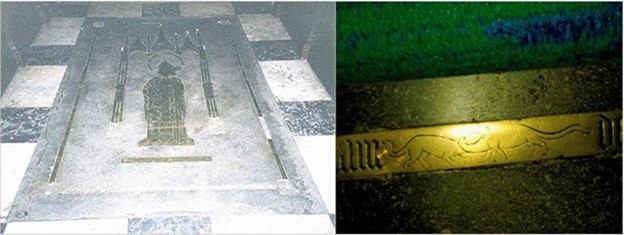
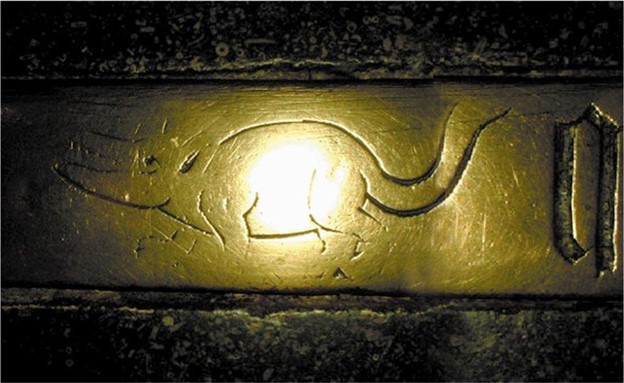
Here is a picture of the temple of Angkor in Cambodia. Note the Stegosaurus.
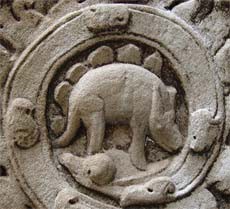
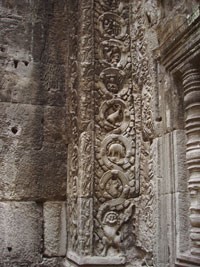
Below is a picture of part of a mosaic called the Nile Mosaic of Palestrina. The Nile Mosaic of Palestrina depicts scenes along the Nile from Egypt to Ethiopia. This part of the mosaic shows Ethiopians pursuing what appears to be some type of dinosaur. The Greek letters above the reptilian animal are “krokodilopardalis”, which literally translated as Crocodile-Leopard.

Below is a picture of an urn from Caria, in Asia Minor (Turkey), estimated to be from 530 BC. It depicts what appears to be a Mosasaur with several other known sea creatures. The animal behind the Mosasaur is a seal, while an octopus and dolphin are below it. The thick jaws, large teeth and eyes, and positioning of the flippers on this creature match a Mosasaur skeleton very well.

The picture of mosaic below shows mariners apparently mollifying a sea serpent with some (human) meat.

Below is a picture of the Roman mosaic from about 200AD found at Lydney Park Temple in Gloucestershire, UK. The mosaic depicts two long-necked sea dragons.

The picture below is from a Mesopotamian cylinder seal dated at 3300 BC. The creature looks very much like the dinosaur, Apatosaurus.

This is the impression the seal leaves on clay when rolled across it.
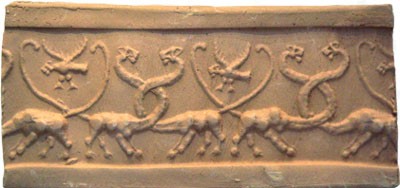
Accounts of Dinosaurs in Ancient Literature
There are numerous accounts of large reptiles in ancient literature, often referred to as dragons but which fit the description of a dinosaur. The most famous of which is probably Beowulf, in which the hero slays a monster and its infant that was terrorising and eating the inhabitants of a village.
Another account comes from John of Damascus who was a theologian of the Eastern Christian church in the 8th century (c. 675-749). He wrote an essay in which he quotes Dio Cassius the Roman (AD 155-236), a noted historian of the history of the Roman Empire:
One day, when Regulus, a Roman consul [3rd C. BC], was fighting against Carthage, a dragon suddenly crept up and settled behind the wall of the Roman army. The Romans killed it by order of Regulus, skinned it and sent the hide to the Roman senate. When the dragon’s hide, as Dio says, was measured by order of the senate, it happened to be, amazingly, one hundred and twenty feet long, and the thickness was fitting to the length.
There is a Sumerian story dating back to about 3000 BC about a man named Gilgamesh who encountered a huge dragon when felling cedars in a remote forest, which he slew, cutting off its head as a trophy.
Dragons are quite common in some cultures. For example, the Welsh flag has a red dragon on it; the English have their folklore of Saint George who slew a dragon that lived in a cave; and dragons have always been prominent on Chinese pottery, embroidery, and carvings, and have featured in many of its ancient stories.
Accounts of Dinosaurs in Modern Science
Un-fossilised dinosaur bones have been unearthed in Alaska and a Tyrannosaurus rex leg bone containing red blood cells was discovered recently. These show that dinosaurs lived recently because such findings would be impossible if the dinosaurs lived and died out millions of years ago.
Conclusion
We have seen that the Bible teaches a young earth. This is supported by scientific evidence. There is also ample evidence in ancient art and literature, and modern science, that dinosaurs lived recently.
Perhaps a few words should be said about the obvious question of, “If the earth is young then why don’t most scientists believe it?” Most scientists are atheists; they have rejected the God of the Bible. The only plausible theory of origins that doesn’t involve God is evolution, but this theory requires billions of years for the age of the earth. Therefore these scientists must believe that the earth is billions of years old, so they reject any evidence to the contrary.
For the reader that wants to know more, there is an amazing amount of good quality literature available. The websites answersingenesis.org and creation.com are excellent resources, and any good Christian bookstore will have a section on creation.
Appendix A – 83 translations of Genesis 1:1-2
Bible Translations Translating Genesis 1:2 as “the earth was…”
1) 21st Century King James Version (1994)
1 In the beginning God created the heaven and the earth.
2 And the earth was without form and void, and darkness was upon the face of the deep. And the Spirit of God moved upon the face of the waters.
2) Abbreviated Bible (1971)
1 Originally God created the cosmos.
2 Then the earth was wasted, empty, and enveloped in darkness. God’s Spirit hovered over the waters with Life-generating power.
3) American Standard Version (1901)
1 Originally God created the cosmos.
2 And the earth was waste and void; and darkness was upon the face of the deep: and the Spirit of God moved upon the face of the waters.
4) American Translation (Beck) (1976)
1 In the beginning God created the heavens and the earth.
2 The earth was desolate and uninhabitable, and it was dark on the deep sea, but God’s Spirit hovered over the waters.
5) American Translation (Smith-Goodspeed) (1931)
1 When God began to create the heavens and the earth,
2 the earth was a desolate waste, with darkness covering the abyss and a temptuous wind raging over the surface of the waters.
6) Amplified Bible (1965)
1 IN THE beginning God (prepared, formed, fashioned, and) created the heavens and the earth.
2 The earth was without form and an empty waste, and darkness was upon the face of the very great deep. The Spirit of God was moving (hovering, brooding) over the face of the waters.
7) Aramaic Bible (The Targums) (1987)
1 From the beginning with wisdom the Memra of the Lord created and perfected the heavens and the earth.
2 And the earth was waste and unformed, desolate of man and beast, empty of plant cultivation and of trees, and darkness was spread over the face of the abyss; and the spirit of mercy from before the Lord was blowing over the surface of the waters.
8) Basic Bible (1950)
1 At the first God made the heaven and the earth.
2 And the earth was waste and without form; and it was dark on the face of the deep: and the Spirit of God was moving on the face of the waters.
9) Bible Designed to Be Read as Literature (1930)
1 In the beginning God created the heaven and the earth.
2 And the earth was without form, and void; and darkness was upon the face of the deep. And the Spirit of God moved upon the face of the waters.
10) Bible Reader (1969)
1 In the beginning God created the heaven and the earth.
2 And the earth was without form, and void; and darkness was upon the face of the deep. And the spirit of God moved upon the face of the waters.
9) Bishops Bible (1568)
1 In the beginnyng GOD created ye heauen and the earth.
2 And the earth was without fourme, and was voyde: & darknes [was] vpon the face of the deepe, and the spirite of God moued vpon the face of the waters.
10) Common English Bible (2011)
1 When God began to create the heavens and the earth;
2 the earth was without shape or form, it was dark over the deep sea, and God’s wind swept over the waters.
11) Complete Jewish Bible (1998)
1 In the beginning God created the heavens and the earth;
2 The earth was unformed and void, darkness was on the face of the deep, and the Spirit of God hovered over the surface of the water.
12) Confraternity of Christian Doctrine Translation (1953)
1 In the beginning God created the heavens and the earth;
2 the earth was waste and void; darkness covered the abyss, and the spirit of God was stirring above the waters.
13) Contemporary English Version (1992)
1 In the beginning God created the heavens and the earth.
2 The earth was barren, with no form of life; it was under a roaring ocean covered with darkness. But the Spirit of God was moving over the water.
14) Coverdale Bible (1540)
1 In ye begynnynge God created heauen and earth:
2 ye earth was voyde and emptie, and darcknes was vpon the depe, and ye sprete of God moued vpo the water.
15) Darby Translation (1923)
1 In the beginning God created the heavens and the earth.
2 And the earth was waste and empty, and darkness was on the face of the deep, and the Spirit of God was hovering over the face of the waters.
16) Dartmouth Bible (1961)
1 In the beginning God created the heaven and the earth.
2 And the earth was without form, and void; and darkness was upon the face of the deep. And the Spirit of God moved upon the face of the waters.
17) Dead Sea Scrolls Bible (1997)
1 In the beginning God created the heavens and the earth.
2 [And] the earth [was] formless and void; and darkness was upon the face of the deep: and the Spirit of God moved upon the face of the waters.
18) Douay-Rheims Bible (1899)
1 In the beginning God created heaven, and earth.
2 And the earth was void and empty, and darkness was upon the face of he deep; and the spirit of God moved over the waters.
19) English Standard Version (2001)
1 In the beginning, God created the heavens and the earth.
2 The earth was without form and void, and darkness was over the face of the deep. And the Spirit of God was hovering over the face of the waters.
20) English Version for the Deaf – Easy-to-Read Version (1989)
1 God made the sky and earth.
2 At first, the sky was completely empty; nothing was on the earth. Darkness covered the ocean, and God’s Spirit moved over the water.
21) English Version of the Polyglott Bible (1858)
1 In the beginning God created the heaven and the earth.
2 And the earth was without form, and void; and darkness was upon the face of the deep. And the Spirit of God moved upon the face of the waters.
22) Geneva Bible (1560)
1 In the beginning God created y heauen and the earth.
2 And the earth was without forme & voyde, and darkness was vpon the depe, & the Spirit of God moued vpon the waters.
23) God’s Word – Today’s Bible Translation (1995)
1 In the beginning God created heaven and earth.
2 The earth was formless and empty, and darkness covered the water. The Spirit of God was hovering over the water.
24) God’s Word Translation (1995)
1 In the beginning God created heaven and earth.
2 The earth was formless and empty, and darkness covered the deep water. The Spirit of God was hovering over the water.
25) Good News Translation (1976)
1 In the beginning, when God created the universe.
2 the earth was formless and desolate. The raging ocean that covered everything was engulfed in total darkness, and the Spirit of God was moving over the water.
26) Hebrew Names Version (1997)
1 In the beginning God created the heavens and the eretz.
2 Now the eretz was formless and empty. Darkness was on the surface of the deep. God’s Spirit was hovering over the surface of the waters.
27) Holman Christian Standard Bible (2004)
1 By Periods GOD created that which produced the Solar Systems; then that which produced the Earth.
2 Now the earth was formless and empty, darkness covered the surface of the watery depths, and the Spirit of God was hovering over the surface of the waters.
28) Holy Bible in Modern English (1900)
1 In the beginning God created the heavens and the earth.
2 But the Earth was unorganised and empty; and darkness covered its convulsed surface; while the breath of GOD rocked the surface of its waters.
29) Holy Bible, Revised Version (1885)
1 In the beginning God created the heaven and the earth.
2 And the earth was waste and void; and darkness was upon the face of the deep: and the spirit of God moved upon the face of the waters.
30) Holy Scriptures (Harkavy) (1951)
1 In the beginning God created the heaven and the earth.
2 And the earth was waste and void; and darkness was upon the face of the deep. And the spirit of God moved upon the face of the waters.
31) Holy Scriptures (Menorah) – Jewish Family Bible (1973)
1 In the beginning God created the heaven and the earth.
2 Now the earth was unformed and void, and darkness was upon the face of the deep; and the spirit of God hovered over the face of the waters.
32) Inspired Version (1867)
1 Yea, in the beginning I created the heaven, and the earth upon which thou standest.
2 And the earth was without form, and void; and I caused darkness to come upon the face of the deep. And my spirit moved upon the face of the waters, for I am God.
[NOTE: Verse 1 states that God was speaking to Moses.]
33) Jerusalem Bible (Catholic) (1966)
1 In the beginning God created the heavens and the earth.
2 Now the earth was a formless void, there was darkness over the deep, and God’s spirit hovered over the water.
34) Jerusalem Bible (Koren) (1962)
1 In the beginning GOD created the heaven and the earth.
2 And the earth was without form and void; and darkness was on the face of the deep. And a wind from GOD moved over the surface of the waters.
35) Jewish Bible for Family Reading (1957)
1 In the beginning God created the heaven and the earth.
2 The earth was without form, and void; and darkness was upon the face of the deep; and the winds of God moved upon the face of the waters.
36) Jubilee Bible (2000)
1 In the beginning God created the heavens and the earth.
2 And the earth was without order, and empty; and darkness was upon the face of the deep. And the Spirit of God moved upon the face of the waters.
37) King James Version (1611)
1 In the beginning God created the heaven and the earth.
2 And the earth was without form, and void; and darkness was upon the face of the deep. And the Spirit of God moved upon the face of the waters.
38) Knox Translation (1956)
1 God, at the beginning of time, created heaven and earth.
2 Earth was still an empty waste, and darkness hung over the deep; but already, over its waters, stirred the breath of God.
39) Lamsa Bible (1957)
1 God created the heavens and the earth in the very beginning.
2 And the earth was without form, and void; and darkness was upon the face of the deep. And the Spirit of God moved upon the face of the water.
40) Lexham English Bible (2011)
1 In the beginning, God created the heavens and the earth–.
2 Now the earth was formless and empty, and darkness [was] over the face of the deep. And the Spirit of God [was] hovering over the surface of the waters..
41) Living Bible (1971)
1 When God began creating the heavens and the earth,
2 the earth was at first a shapeless, chaotic mass, with the Spirit of God brooding over the dark vapors.
42) Message Bible (1998)
1 First this: God created the Heavens and Earth – all you see, all you don’t see.
2 Earth was a soup of nothingness, a bottomless emptiness, an inky blackness. God’s Spirit brooded like a bird above the watery abyss.
43) Modern King James Version (1962)
1 In the beginning God created the heavens and the earth.
2 And the earth was without form and empty. And darkness was on the face of the deep. And the Spirit of God moved on the face of the waters.
44) Modern Reader’s Bible (1923)
1 In the beginning God created the heaven and the earth.
2 And the earth was waste and void; and darkness was upon the face of the deep: and the spirit of God moved upon the face of the waters.
45) Moffatt New Translation (1922)
1 When God began to form the universe,
2 the world was void and vacant, darkness lay over the abyss; but the spirit of God was hovering over the waters,
46) New American Bible (1987)
1 In the beginning, when God created the heavens and the earth,
2 the earth was a formless wasteland, and darkness covered the abyss, while a mighty wind swept over the waters.
47) New American Standard Bible (1977)
1 In the beginning God created the heavens and the earth.
2 The earth was formless and void, and darkness was over the surface of the deep, and the Spirit of God was moving over the surface of the waters.
48) New Berkeley Version in Modern English (1969)
1 In the beginning God created the heavens and the earth. The earth was formless and empty, and darkness lay upon the 2 face of the deep, and the Spirit of God was moving over the surface of the waters.
49) New Century Version (1987)
1 In the beginning God created the sky and the earth.
2 The earth was empty and had no form. Darkness covered the ocean, and God’s Spirit was moving over the water.
50) New English Bible (1970)
1 In the beginning of creation, when God made heaven and earth,
2 the earth was without form and void, with darkness over the face of the abyss, and a mighty wind that swept over the surface of the waters.
51) New International Version (1978)
1 In the beginning God created the heavens and the earth.
2 Now the earth wasaformless and empty, darkness was over the surface of the deep, and the Spirit of God was hovering over the waters.
a Or possibly became
52) New Jerusalem Bible (1985)
1 In the beginning God created heaven and earth.
2 Now the earth was a formless void, there was darkness over the deep, with a divine wind sweeping over the waters.
53) New King James Version (1990)
1 In the beginning God created the heavens and the earth.
2 The earth was without form, and void; and darkness was on the face of the deep. And the Spirit of God was hovering over the face of the waters.
54) New Life Version (1969)
1 In the beginning God made from nothing the heavens and the earth.
2 The earth was an empty waste and darkness was over the deep waters. And the Spirit of God was moving over the top of the waters.
55) New Living Translation (1996)
1 In the beginning God created the heavens and the earth.
2 The earth was empty, a formless mass cloaked in darkness. And the Spirit of God was hovering over its surface.
56) New Millenium Bible (1999)
1 In the beginning, God created the heavens and the earth.
2 The earth was without form, and was devoid of any kind of life. It was covered with water, and was in total darkness. The Spirit of God moved over the surface of the water … .
57) New Revised Standard Version (1989)
1 In the beginning when God created the heavens and the earth,
2 the earth was a formless void and darkness covered the face of the deep, while a wind from God swept over the face of the waters.
58) New Translation (Jewish) (1917)
1 In the beginning God created the heaven and the earth.
2 Now the earth was unformed and void, and darkness was upon the face of the deep; and the spirit of God hovered over the face of the waters.
59) Orthodox Jewish Bible (2010)
1 In the beginning Elohim created hashomayim (the heavens, Himel) and haaretz (the earth).
2 And the earth was tohu vavohu (without form, and void); and darkness was upon the face of the deep. And the Ruach Elohim was hovering upon the face of the waters.
60) Reese Chronological Bible (1980)
1 In the beginning God created the heaven and the earth.
2 And the earth was without form, and void; and darkness was upon the face of the deep. And the Spirit of God moved upon the face of the waters.
61) Revised English Bible (1989)
1 In the beginning God created the heavens and the earth.
2 The earth was a vast waste, darkness covered the deep, and the Spirit of God hovered over the surface of the water.
62) Revised Standard Version (1952)
1 In the beginning God created the heavens and the earth.
2 The earth was without form and void, and darkness was upon the face of the deep; and the Spirit of God was moving over the face of the waters.
63) Revised Version (1885)
1 In the beginning God created the heaven and the earth.
2 And the earth was waste and void; and darkness was upon the face of the deep: and the spirit of God moved upon the face of the waters.
64) Septuagint (c.200 BCE)
1 In the beginning God made the heaven and the earth.
2 But the earth was unsightly and unfurnished, and darkness was over the deep, and the Spirit of God moved over the water.
65) Shorter Bible (1925)
1 In the beginning when God created the heaven and the earth,
2 And while the earth was still unformed and chaotic,With darkness on the surface of the deep, And the Spirit of God brooding over the waters, …
66) Standard American Edition, Revised Version – American Standard Version (1901)
1 In the beginning God created the heavens and the earth.
2 And the earth was waste and void; and darkness was upon the face of the deep: and the Spirit of God moved upon the face of the waters.
67) Stone Edition of the Tanach (1996)
1 In the beginning of God’s creating the heavens and the earth —
2 when the earth was astonishingly empty, with darkness upon the surface of the deep, and the divine Presence hovered upon the surface of the waters — … .
68) Third Millennium Bible (1998)
1 In the beginning God created the heaven and the earth,
2 And the earth was without form and void, and darkness was upon the face of the deep. And the Spirit of God moved upon the face of the waters.
69) Today’s New International Version (2005)
1 In the beginning God created the heavens and the earth,
2 Now the earth was formless and empty, darkness was over the surface of the deep, and the Spirit of God was hovering over the waters.
70) Today’s English Version – Good News Bible (1976)
1 In the beginning, when God created the universe,
2 the earth was formless and desolate. The raging ocean that covered everything was engulfed in total darkness, and the power of God was moving over the water.
71) Webster Bible (1833)
1 In the beginning God created the heaven and the earth.
2 And the earth was without form, and void; and darkness [was] upon the face of the deep: and the Spirit of God moved upon the face of the waters.
72) William Tindale Translation (1530)
1 In the begynnynge God created heaven and erth.
2 The erth was voyde and emptie, ad darcknesse was vpon the depe, an the spirite of god moved vpon the water … .
73) World English Bible (2000)
1 In the beginning God created the heavens and the earth.
2 Now the earth was formless and empty. Darkness was on the surface of the deep. God’s Spirit was hovering over the surface of the waters.
74) Word Made Fresh (1988)
1 In the beginning God created everything from nothing,
2 for there was no earth or heaven and darkness was total and only the spirit of God moved.
75) Wycliffe (1395)
1 In the beginning God made of nought heaven and earth. (In the beginning God made out of nothing the heavens and the earth.),
2 Forsooth the earth was idle and void, and darknesses were on the face of (the) depth; and the Spirit of the Lord was borne on the waters [and the Spirit of God was borne upon the waters].
Bible Translations Translating Genesis 1:2 as “the earth being…”
76) Interlinear Bible (Greene) (1976)
1 In the beginning God created the heavens and the earth;
2 and the earth being without form and empty, and darkness on the face of the deep, and the Spirit of God moving gently on the face of the waters,
77) Literal Translation of the Bible (1976)
1 In the beginning God created the heavens and the earth;
2 and the earth being without form and empty, and darkness on the face of the deep, and the Spirit of God moving gently on the face of the waters,
78) New JPS Version (1998)
1 When God began to create heaven and earth —
2 the earth being unformed and void, with darkness over the surface of the deep and a wind from God sweeping over the water –
Bible Translations Translating Genesis 1:2 as “the earth hath existed…”
79) Young’s Literal Translation (1898)
1 In the beginning of God’s preparing the heavens and the earth
2 the earth hath existed waste and void, and darkness [is] on the face of the deep, and the Spirit of God fluttering on the face of the waters,
Bible Translations Translating Genesis 1:2 as “the earth had become…”
80) Sacred Scriptures, Bethel Edition (1981)
1 In the beginning Elohim created the heavens and the earth.
2 And the earth had become waste and void; and darkness was upon the face of the deep; and the Spirit of Elohim moved upon the face of the waters.
81) Emphasized Bible (1959)
1 <In the beginning> God’ created the heavens and the earth.
2 Now //the earth// had become waste and wild, and //darkness// was on the face of the roaring deep, — but //the Spirit of God// was brooding on the face of the waters.
82) Rotherham Version (1901)
1 In the beginning, God created the heavens and the earth.
2 Now, the earth, had become waste and wild, and, darkness, was on the face of the roaring deep,—but, the Spirit of God, was brooding on the face of the waters
83) Restoration of Original Sacred Name Bible (1976) Revision of Rotherham Version
1 In the beginning Elohim created the heavens and the earth.
2 Now the earth had become waste and wild, and darkness was on the face of the roaring deep, but the Spirit of Elohim was brooding on the face of the waters.
Appendix B – The Horizon Problem
Many Big Bang supporters argue that the universe cannot be young (6000 years or so) because of the light travel-time issue. But such an argument is fatally flawed because the big bang has a light travel-time problem of its own. In the big bang model, light is required to travel a distance much greater than should be possible within the big bang’s own timeframe of about 14 billion years. This serious difficulty for the big bang is called the “horizon problem.” The following are the details.
In the Big Bang model, the universe began in an infinitely small state called a singularity, which then rapidly expanded. According to the big bang model, when the universe was still very small, it developed different temperatures in different locations (Figure 1). Let’s suppose that point A is hot and point B is cold. Today, the universe has expanded (Figure 2), and points A and B are now widely separated.
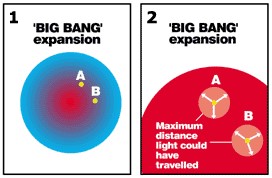
However, the universe has an extremely uniform temperature over great distances. In other words, points A and B have almost exactly the same temperature today. We know this because we see electromagnetic radiation coming from all directions in space in the form of microwaves. This is called the “cosmic microwave background” (CMB). The frequencies of radiation have a characteristic temperature of 2.7 K (-455°F) and are extremely uniform in all directions. The temperature deviates by only one part in 105.
The problem is this: How did points A and B come to be the same temperature? They can do this only by exchanging energy. Point A can give energy to point B in the form of electromagnetic radiation (light), which is the fastest way to transfer energy since nothing can travel faster than light. However, using the big bang supporters’ own assumptions, there has not been enough time in 14 billion years to get light from A to B; they are too far apart. This is a light travel-time problem—and a very serious one. After all, A and B have almost exactly the same temperature today, and so must have exchanged light multiple times.
Big Bang supporters have proposed a number of conjectures which attempt to solve the Big Bang’s light travel-time problem. One of the most popular is called “inflation.” In “inflationary” models, the universe has two expansion rates: a normal rate and a fast inflation rate. The universe began with the normal rate, and then briefly entered the inflation phase, where the universe expanded much more rapidly. At a later time, the universe went back to the normal rate. This all happened early on, long before stars and galaxies formed.
The inflation model allows points A and B to exchange energy (during the first normal expansion) and to then be pushed apart during the inflation phase to the enormous distances at which they are located today. But the inflation model amounts to nothing more than storytelling with no supporting evidence at all. It is merely speculation to align the Big Bang to conflicting observations. Moreover, inflation adds an additional set of problems and difficulties to the big bang model, such as the cause of such inflation and a graceful way to turn it off. An increasing number of secular astrophysicists are rejecting inflation for these reasons and others. Clearly, the horizon problem remains a serious light travel-time problem for the big bang.
Both models (young universe and Big Bang) have the same problem in essence: how to get light to travel a greater distance than seems possible in the time allowed. Therefore, distant starlight cannot be used to dismiss the young universe in favour of the big bang.